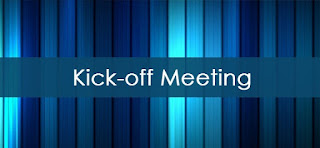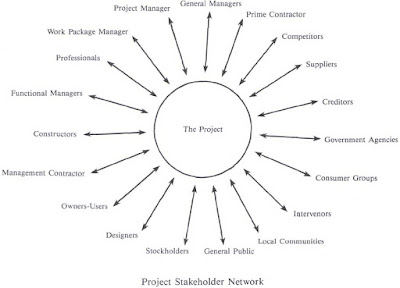Hello fans! Welcome back to my Blog—PMGT 502- Effective
Communications for Managing Projects.
Last week we discussed PM
Communications Tools, this week we discuss the dreaded “Meetings”!
Yes, this week’s discussion is on meetings, specifically kick-off
meetings, and meeting minutes.
As mentioned last week, I am a PM novice. Though never a “formal”
PM, I have worked various projects in my day. In addition, I have many, many
years’ experience with meetings in government, aviation, real estate, and
non-profit industries. And no matter how many times I have experienced it, it
never ceases to amaze me when leadership has questionable styles. Let us be frank, some managers never really
have a set plan or agenda for any of the projects they do…they just wing it.
“The project kick-off meeting is the
official start of the project” (Dow & Taylor, 2015 pg. 111). It is during this time that
the scope, goals, and objectives are explained and agreed upon by the stakeholders.
“This ensures that everyone has the same information about the project, at the
same time, so that everyone can focus on what the team has to deliver” (Dow &
Taylor, 2015 pg. 111). So how
can such a common sense, critically important concept be overlooked? Here is an
example of a project in which there was no kick-off meeting.
During my time as a volunteer at the local charter school,
it was known that the school desperately needed a new playground set. The
current playground set was improperly installed, failing to meet recommended
manufacturer installation guidelines for height and hardware. In addition, the
playground equipment was not age appropriate for the grades utilizing the
playground during recess and after-school activities. End result was students
receiving injuries daily. The board of directors, along with school staff, initialed
a project to replace the equipment, including plans for fundraisers to pay for
the new equipment and labor. During inception, the project planners did not
take into account all stakeholders.
The parents’ advisory council (PAC) is a committee that
organizes all volunteer parents and guardians. Without notification or
information, the PAC was in the dark. The PAC, feeling something needed to be
done about the playground, instituted their own plan of fundraising efforts.
The result was two units of the same organization competing against each other for
the same end project. If, at the beginning, the Board and PAC, along with other
stakeholders, would have participated in a kick-off meeting to discuss the
playground project, I believe the issues of the project would have been
prevented.
Working in unison, the school, as a whole, could have taken advantage
and shared common resources, fundraiser efforts, and available sponsors to get
the project done. Furthermore, including vendors (external stakeholders) in the
planning could have helped established realistic budget and time estimates to
have specific objectives/goals for the project. This playground project failed
before it was truly implemented, and it was because of lack of communication
between stakeholders that would have been prevented had we partaking in a
kick-off meeting.
Okay, that was an extreme (but common) example of what I
deal with in my non-profit capacity. Expanding upon some best practices
failures, let us review the concept of meeting minutes. So what are meeting
minutes? “The official record of the proceedings of a deliberative assembly is
usually called the minutes…” (Robert,
Honemann, & Balch, 2011 pg. 468). Not all organizations
utilize a formal meeting record keeping system. The question is, why not? In my
humble opinion, based on my experience, there are a few reasons why an
organization would not have meeting minutes.
The first reason is
that meetings are looked upon as necessary evils. People often feel meetings are worthless,
time-wasting endeavors often forced by leadership. If this is the attitude of
those involved, it is no wonder nobody would take the time to make an official
record of this activity.
The second reason I feel no records are officially kept is
transparency. Leadership or other stakeholders do not feel comfortable or confident
in their decision-making. This usually means, in my experience, that decisions
are made but not supported or acknowledged if the situation goes off track. By
not having an official record of the meeting, there is no forced accountability
of those involved. As farfetched as this opinion may seem, this was actually my
experience in the military during my final years. Unfortunately, there are some
leaders (not all, just some) that care more about their own careers than taking
care of the unit under their responsibility. These are the leaders who only
accept credit when a project goes well, and passes the buck when a project goes
wrong. I can speak endlessly of the responsibilities of leadership and ethical management,
however, I will save that for another blog! Thus endeth the sermon.
Lastly, I believe the simple reason meeting minutes are not
kept is unfamiliarity. Though information or training is provided or found
easily, individuals within organizations may not know how to implement a simple
record keeping system or feel one is not needed. This was the case with PAC (as
referenced above). When I first volunteered with PAC, I found that the meetings
were never preceded with an agenda nor were they followed by release of meeting
minutes. Volunteer leadership simply felt they did not need meeting minutes. This has since been rectified, but it
is anyone’s guess for how long it will stay.
The first reason records should be kept is to have an
official record that a meeting did take
place, when it took place, and who was in attendance. This provides historical
record for the organization. Second reason is to document decisions, objectives,
and goals met. During the course of the meeting, some productivity is hopefully
accomplished. This needs to be reflected in the minutes. Third reason to
implement meting minutes is to document the next steps. During the course of
the meeting, future objectives and goals can be identified. These objectives
need to be track for accountability. Who is supposed to do what by when? Identifying
the “To-Do” list can re-enforce the importance
of accomplishing tasks and moving the organization forward. During the next meeting,
usually it is standard practice to review previous meeting minutes. These
previous minutes can be used to set the agenda for current meeting by identifying
open tasks and timelines. Instituting an organized, formal meeting minutes
system is an organizational best practice!
This week, we discussed meetings and how failing to
incorporate a project kick-off meeting can be hazardous to the health of the
project. Showcasing kick-off meeting importance, I provided an example of how
not having a kick-off meeting caused a local charter to school a desperately
needed playground. After which, we discussed meeting minutes and some reasons why
organizations may not use them. In addition, we discussed some advantages of
why an organization should implement
a meeting minutes system now.
I would like to express my gratefulness and gratitude to my
readers! I encourage and appreciate all feedback for this topic and suggestions
for future projects!
Damien
References
Dow, W., & Taylor, B. (2015). Project management
communication tools. Renton, WA: Dow Publishing LLC.
Robert, H. M., Honemann, D. H., & Balch, T. J.
(2011). Robert's rules of order: Newly revised (11th ed.). Philadelphia,
PA: Da Capo Press.






No comments:
Post a Comment